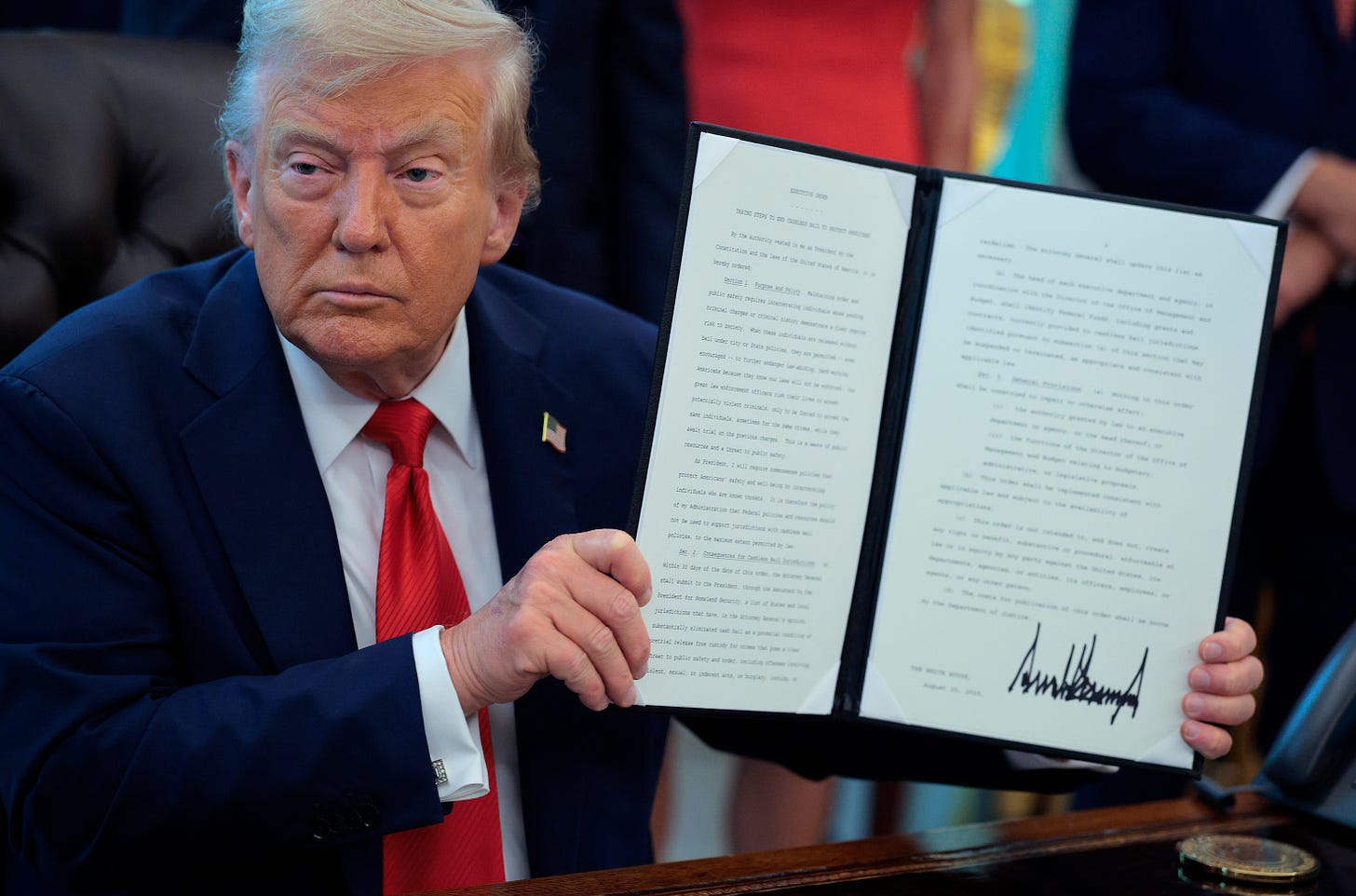Trump's flag burning executive order flames out
Nothing about this is real law.
PN is supported by paid subscribers. Become one 👇
Scroll to the bottom for a note from Aaron about the mass shooting yesterday in Minneapolis.
On Monday, President Trump announced suddenly that he’s banning flag burning.
“It’s called death! What happens when you burn a flag is the area goes crazy.” Trump babbled incoherently as he signed the executive order. “When you burn the American flag, it incites riots at levels people have never seen before.”
This is a transparent attempt to transform protected speech into criminal conduct, despite decades of Supreme Court precedent barring just that. And it was immediately challenged by Jay Carey, an army veteran who set fire to an American flag in Lafayette Park across from the White House.
Note that, despite Trump’s bloviating, the crowd did not “go crazy.” Carey was taken into custody without incident, and, as of this writing, has yet to be charged.
Texas v. Johnson
Trump’s executive order bizarrely justifies itself by pointing to the very Supreme Court case that protected flag banning as justification for his purported ban:
Notwithstanding the Supreme Court’s rulings on First Amendment protections, the Court has never held that American Flag desecration conducted in a manner that is likely to incite imminent lawless action or that is an action amounting to “fighting words” is constitutionally protected. See Texas v. Johnson, 491 U.S. 397, 408-10 (1989).
Texas v. Johnson involved an avowed communist named Gregory Johnson who burned an American flag outside the Dallas City Hall to protest the renomination of Ronald Reagan at the 1984 RNC. He was convicted of desecrating a venerated object under Texas Penal Code and sentenced to a year in jail and a $2,000 fine.
The Texas Supreme Court reversed the conviction, and the state appealed to the US Supreme Court. In a 5-4 ruling, the majority, which included progressive Justice William Brennan and arch conservative Justice Antonin Scalia, held that flag burning is expressive conduct protected by the First Amendment.
The minority, including Chief Justice Rehnquist, Justice Sandra Day O’Connor, and liberal Justice John Paul Stevens, huffed that the flag occupied a special place in American consciousness, making its desecration deeply offensive to most Americans. But the majority wasn’t having it: "If there is a bedrock principle underlying the First Amendment, it is that the Government may not prohibit the expression of an idea simply because society finds the idea itself offensive or disagreeable."
Congress gamely tried again, passing the Flag Desecration Penalties Act, making it illegal to burn a flag nationwide. And once again, the Supreme Court ruled 5-4 in a case called US v. Eichman that flag burning is expressive conduct protected by the First Amendment.
“Punishing desecration of the flag dilutes the very freedom that makes this emblem so revered, and worth revering,” the court reiterated.
So, why this executive order?
Trump knows that he can’t prosecute flag burning as such. Instead he’s trying to define down incitement such that burning a flag can be treated as inherently inflammatory and thus criminal.
When he refers to “imminent lawless action,” he’s quoting the famous 1969 Supreme Court decision in Brandenburg v. Ohio, in which KKK leader Clarence Brandenburg was prosecuted for calling for violence against Black and Jewish people. The Court overturned his conviction, codifying what became known as the Brandenburg standard for incitement: “The constitutional guarantees of free speech and free press do not permit a State to forbid or proscribe advocacy of the use of force or of law violation except where such advocacy is directed to inciting or producing imminent lawless action and is likely to incite or produce such action.” [Emphasis added.]
Trump wants to treat flag-burning as definitionally likely to produce “imminent lawless action.” That’s why he’s ranting about people going “crazy” when they see the flag burned. But the Supreme Court outright rejected this logical leap in Texas v. Johnson.
“To accept Texas' arguments that it need only demonstrate ‘the potential for a breach of the peace,’ and that every flag burning necessarily possesses that potential, would be to eviscerate our holding in Brandenburg,” the majority wrote. “This we decline to do.”
Similarly, Trump wants to treat flag burning like “fighting words,” another category of incendiary speech described by the Supreme Court in a 1942 case called Chaplinsky v. New Hampshire. There the Court upheld the conviction of a Jehovah’s Witness who shouted insults against other faiths, which the justices described as “insulting or ‘fighting’ words — those which, by their very utterance, inflict injury or tend to incite an immediate breach of the peace” and are outside the protection of the First Amendment.
But, as First Amendment lawyer Ken White pointed out in a very helpful Bluesky thread, Chaplinsky predated a whole host of other Supreme Court rulings protecting Americans’ rights to say extremely offensive things, rendering the “fighting words” doctrine more or less defunct.
And, in fact, the Supreme Court addressed “fighting words” in Texas v. Johnson:
Nor does Johnson's expressive conduct — that is, burning the flag — fall within that small class of "fighting words" that are "likely to provoke the average person to retaliation, and thereby cause a breach of the peace." No reasonable onlooker would have regarded Johnson's generalized expression of dissatisfaction with the policies of the Federal Government as a direct personal insult or an invitation to exchange fisticuffs.
Clearly some lawyer in the White House told Trump he could prosecute flag burning as both incitement to imminent lawless action and fighting words — that’s why he’s nattering on about “some that are going crazy for doing it, others that are angry about them doing it.” But that White House lawyer didn’t read the entire holding in Texas v. Johnson. Or, if he did, he didn’t tell his boss about it.
Points for creativity?
After outlining his elaborate fantasies to redefine flag-burning as incitement, Trump and his minions posited even more outlandish scenarios to punish flag burners.
Maybe flag burning is a “hate crime?” Maybe it violates Americans’ civil rights “as a calculated act to intimidate and threaten violence against Americans because of their nationality and place of birth?” Maybe it’s “conspiracies?”
(It is none of those things.)
Perhaps most insidiously, Trump suggests that Secretary of State Marco Rubio and Homeland Security Secretary Kristi Noem should deport any immigrant who dares to burn the US flag — a legal exercise of the right to expressive speech which is protected by the Constitution.
The executive branch’s power over deportations is vast, and this Supreme Court shows very little interest in reining it in. But at least two courts recently ruled that speech the government dislikes cannot serve as a basis for detaining immigrants and treating them as dangerous.
In the case of Mahmoud Khalil, the Columbia University grad student arrested in front of his pregnant wife for organizing pro-Palestinian protests, Judge Michael Fabiarz rejected the government’s move to lock him up based on Secretary Rubio’s declaration that his “participation in antisemitic protests and disruptive activities” fostered a “hostile environment for Jewish students in the United states” and “undermined US policy to combat antisemitism around the world and in the United States.”
“The Secretary’s determination suggests it was based on the Petitioner’s ‘lawful’ ‘beliefs, statements, or associations.’ And ‘beliefs,’ ‘statements,’ and ‘associations’ are generally protected by the First Amendment,” the judge wrote, ordering Khalil released from government custody.
Judge William Sessions III in Vermont reached a similar conclusion with respect to Rumeysa Ozturk, the Tufts University grad student arrested and detained after authoring an opinion piece calling on the school to cut ties with Israel. The judge ruled that, while the government likely has the power to deport Ozturk, it can’t detain her as retaliation for protected speech.
So, if Trump wants to arrest and deport the (potentially nonexistent) class of immigrants who burn American flags, he may run into some trouble in the courts.
Culture war today, tomorrow, and forever
The Justice Department seems less than eager to test out those spiffy new legal theories rolled out in the flag burning EO. Perhaps they’re aware that, after three decades in which Americans burned flags without sparking a single riot, they’ll have trouble convincing even this Supreme Court that flag burning is de facto incitement.
Meanwhile Jay Carey is still waiting to be charged, although the park police did issue him citations for igniting a fire in an unsecured place and damaging park property.
"What I'm waiting on is our illustrious DC prosecutor to bring up charges, at the behest of our president, and say you need to spend a year in jail,” he told DC’s Fox 5. (US Attorney Pirro is probably too busy cycling through grand juries trying to find someone willing to indict the dastardly Hoagie Hurler.)
Maybe the executive order was an attempt to goad Democrats into adopting the burning flag as its midterm logo — or at the very least, siding with a bunch of unpopular protesters. Maybe it was pure red meat for the base. Whatever it is, it’s not real law, and it seems unlikely to gain serious traction for more than a news cycle or two.
A note from Aaron
As you might have seen on social media, there was a mass shooting at my kids’ school yesterday.
The roughly hour-long period between when we heard dozens of sirens sirens blaring just a few blocks from us and when we learned that our children were not among the deceased and injured was the most agonizing of our lives, and I cannot fathom the pain that the families of the two children who will never come home are feeling today. Both of our kids were confused when we reunited with them, but thankfully they were not in the immediate vicinity of the violence and are less traumatized than their parents.
I want to thank those of you who have reached out to check in and express condolences. It was an awful and bewildering day, but it was also full of reminders of the caring and kindness of our neighbors and friends.
My heart breaks for Annunciation community and the families most directly hurt by this senseless act of gun violence. The teachers are administrators there are tremendous people, and if you’d like to do something to help out, you can consider giving here.
That’s it for today
We’ll be back with more tomorrow. If you appreciate this edition, please do your part to keep Public Notice free by signing up for a paid subscription.
Thanks for reading.






Aaron, I'm praying for your community and your family. My heart breaks for it.
My prayers go with all the parents and children of the school, and all who have suffered through gun violence. You will find a soft piano playing, amazing grace that goes to America 🇺🇸 today.